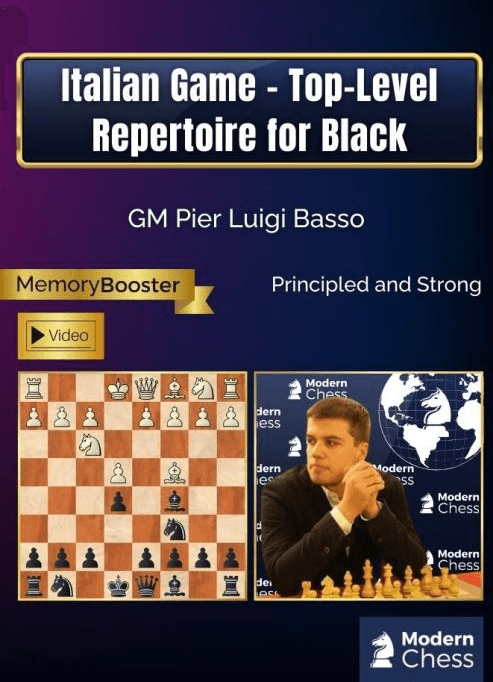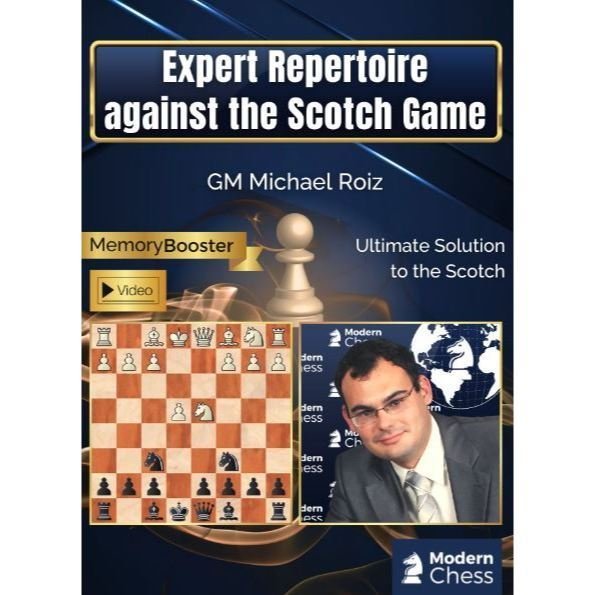GM Michael Roiz keeps building his 1.e4 e5 repertoire with another fascinating work – Expert Repertoire against the Scotch Game. The Scotch Game has always been considered a challenging and ambitious antidote to 1…e5. If you are an 1…e5 player, you should take this opening very seriously.
$100 Original price was: $100.$4Current price is: $4.
10000 in stock
In this database, GM Michael Roiz provides expert solution for Black based on 1.e4 e5 2.Nf3 Nc6 3.d4 exd4 4.Nxd4 Nf6

The move 4…Nf6 has always been considered to be Black’s most ambitious system against the Scotch Game. White should immediately decide how to deal with the defence of the e4-pawn. Objectively speaking, 4…Nf6 is Black’s only way to completely solve the problems. Therefore, it’s not a surprise that this is the top choice of the elite players.
The database consists of 16 theoretical chapters, 20 interactive test positions, a Memory Booster, and a Video Version (3+hours running time).
You can find the package with all 1.e4 e5 databases by Roiz HERE.
The first part of the database is dedicated to the so-called Scotch Four Knights. The first main tabiya arises after 1.e4 e5 2.Nf3 Nc6 3.d4 exd4 4.Nxd4 Nf6 5.Nc3 Bb4 6.Nxc6 bxc6 7.Bd3 d5

The Scotch Four Knights is getting tremendously popular nowadays. Before, it was mainly considered as a drawish system played by less ambitious players. Recently, however, the Scotch Four Knights became part of the repertoire for some very strong players. The fact that a famous theoretician like GM Pavel Eljanov wrote a database about it speaks for itself.
In Chapter 1, Roiz covers the move 8.Bd2 which became rather popular on the high level. Mostly, White players are interested in entering a middlegame position, where the bishops pair will be an important factor.
His suggestion is 8…0-0 9.0-0 Rb8

By involving the queen’s rook, Black eliminates the main tactical point of Bd2: The threat Nxd5 does not exist anymore. As you will see in the analysis of Roiz, Black can even overtake the initiative if White does not play accurately.
The second big juncture is being reached after 8.exd5 0-0 9.0-0 cxd5

This position is dealt with in Chapters 2-5. White has three main moves – 10.Qf3, 10.Bg5, and 10.h3 which is the new main line. The rare moves are covered in Chapter 2. Overall, they are less ambitious and do not pose any problems for Black.
In response to 10.Qf3, Roiz suggests 10…Bg4 11.Qg3 c5!?

This ambitious continuation was only seen in 1 game so far. Black grabs some space and intents to deprive the Bd3 of its diagonal with …c5-c4. The concrete analysis shows that Black enjoys excellent counterplay in this line.
Against 10.Bg5, Roiz considers 10…Be6 is to be the most precise response.

The advantage of this move over the traditional 10…c6 is that Black keeps the option of playing …c7-c5.
The most important position of the Scotch Four Knights arises after 10.h3

This modest-looking move is actually White’s main attempt to fight for an advantage in this position. By covering g4, White secures f3 for his queen. Vladimir Kramnik successfully employed this approach in 2012, and since then it has become highly popular.
The suggestion of Roiz is 10…Rb8!? The rook isn’t only keeping an eye on the b2-pawn, but also might be activated along the 6th rank. In the arising complicated positions, Black has every chance to outplay his opponent.
The remaining part of the database features the main position arising after 5.Nxc6 bxc6

At this point, White’s main choice is by far 6.e5. The alternatives, however, should be taken seriously. For instance, Chapter 6 is dedicated to the move 6.Qe2. Among White’s minor possibilities on move 6 this one is the most ambitious. White covers his king from the potetnial pin, making..e4-e5 more attractive. On the downside, this move is very artificial as the Bf1 is blocked. There are few decent options at Black’s disposal at this point.
Roiz suggests 6…Qe7 7.Nc3 g6!?

For some reason, this natural move is practically unexplored on GM’s level. At the same time, fianchetto seems especially effective now, when the queen’s knight is on c3. The subsequent analysis shows that Black enjoys sufficient counterplay.
The other deviations from the main line 6.Nd2 and 6.Bd3 are dealt with in Chapters 7 and 8. In both cases, Black obtains good position.
From Chapter 9, Roiz starts examining the main tabiya of the Scotch Game arising after 6.e5 Qe7 7.Qe2 Nd5

This is by far the most important theoretical position. White hopes that his better pawn structure will provide an advantage in the long-term. It’s not a surpise that most of the endgames are good for White. On the other hand, with the pawn on e5, White’s position is a bit overextended. By using this pawn as well as White’s problematic development, Black manages to create enough counterplay.
White’s main moves here are 8.c4 and 8.h4 which was recently suggested by GM Ivan Cheparinov in his database Scotch Game – Expert Repertoire for White.
The moves 8.g3 and 8.Nd2 are covered in Chapters 9 and 10.
After 8.c4, Roiz suggests 8…Ba6

By pinning the c4-pawn, Black keeps his knight in the centre. Also, Black is ready to put pressure on the e5-pawn by means of …g7-g6 followed by …Bg7. The long-term risk is that if Black does not play dynamically, the a6-bishop might remain out of play.
Even though Roiz provides detailed coverage of all the alternatives, we will now focus on the main line which goes 9.b3 g6

Black is ready to put pressure on the e5-pawn by means of …Bg7 on the next move. The move 10.Ba3 will be answered with 10…Nb4. This position is covered in Chapter 13.
If White expands with 10.f4, Roiz suggests the aggressive 10…g5!? which is aimed at exploiting the lack of development in White’s camp and destroy the centre. This line is covered in Chapter 14.
The consistent 10.Bb2 was common a while ago but can be rarely seen on the GM’s level nowadays. In Chapter 15, Roiz shows how Black should deal with this line.
The last Chapter 16 is dedicated to 8.h4.

This original move is equally common as the main 8.c4 nowadays. It was first seen in the mid 80’es but gained its popularity mainly due to the efforts of GM Alexander Morozevich, who introduced it on a high level in 2015. Among White’s key ideas from now is involving the Rh1 via 3rd rank. Also, Bc1-g5 might be a useful resource in some cases.
Against this line, Roiz suggests 8…a5!? and justifies his choice in the following way:
“I find this reply the most ambitious, although there were many alternatives at Black’s disposal. Black not only vacates a6 for his bishop, but also makes it tougher for White to opt for fianchetto in view of …a5-a4.”
In this chapter, Roiz proves that Black has an adequate counterplay against 8.h4. You will also find some interesting novelties!
Average Star Rating: 0.0 out of 5 (0 vote)
If you finish the payment today, your order will arrive within the estimated delivery time.Only logged in customers who have purchased this product may leave a review.





Reviews
There are no reviews yet.